Sun activity for November 30, 2023: 4 blobs of sun coming our way
EarthSky sun activity author Dr. C. Alex Young also produces @thesuntoday.
Auroras incoming late tonight and tomorrow night! Four coronal mass ejections (CMEs) are currently headed toward Earth. These blobs of solar plasma and magnetic fields are expected to reach us late today into tomorrow. The first one (late today) will give the south of Earth a glancing blow. And then comes the big punch. Three CMEs should reach us early tomorrow, December 1. In fact – on its journey through space – a large CME that left the sun on November 28 will overtake the two events from the previous day, creating a complicated mass of sun-stuff known as a cannibal CME. Sound scary? Not at all. And it’s going to bring some beautiful auroral displays to northern latitudes! Forecasters are predicting up to a G3 (strong) geomagnetic storm, with auroras that could even be somewhat visible on the horizon to those at latitudes like those in the northern U.S. Good luck, aurora chasers!
Last 24 hours: Sun activity is back to low, with 14 C flares produced between 11 UTC yesterday and 11 UTC today. The largest was a C3.8 flare from sunspot group AR3500 at 14:35 UTC on November 29. This region has remained active after Tuesday’s almost-X flare, firing more flares than any other sunspot group (six out of the 14) as well as producing jets all day. It has kept its beta-gamma magnetic complexity, so the possibility of large M flares remains. It is the largest and most complex of the ten active regions currently on the Earth-viewed side of our sun.
Sun activity for November 29, 2023: Almost-X flare! Auroras incoming
EarthSky sun activity author Dr. C. Alex Young also produces @thesuntoday.
Bam! The sun almost reached X flare levels with an M9.8 released at 19:50 UTC on November 28. An X flare is the strongest category of solar flare. This almost-X came from sunspot region AR3500 near the center of the sun’s disk. It sent a CME (coronal mass ejection) straight toward Earth. Space weather forecasters at NOAA predict this blob of sun-stuff will reach Earth on November 30. This CME is traveling to us behind another CME – released from the sun on November 27 – which is expected to reach us on late November 29. Together, these two solar blasts may provoke G1 (minor) to G2 (moderate) geomagnetic storms at Earth. That means substantial auroras will be visible at higher latitudes. Fingers crossed for clear skies!
Last 24 hours: Sun activity has risen to high after the production of the M9.8 flare. Between 11 UTC yesterday and 11 UTC today, the sun released two M flares and six Cs. The M9.8 came shortly after an M3.4 at 19:13 UTC, November 28. Both flares came from AR3500, and both produced radio blackouts off the west coast of South America. The M3.4’s blackout was rated at R1 (minor), while the almost-X flare produced an R2 (moderate) blackout. AR3500 continues to show a beta-gamma magnetic complexity. The sun currently has ten active regions on its Earth-facing side.
Sun activity for November 28, 2023: More sun-stuff headed toward Earth
EarthSky sun activity author Dr. C. Alex Young also produces @thesuntoday.
The sun is at it again! We saw a huge eruption on the sun yesterday, and it’s headed our way. In fact, the last 24 hours was full of action, with a huge solar burp in the northeast at around 18:24 UTC yesterday, followed by another one slightly further northeast at around 22:23 UTC. And if those two weren’t enough, another blast came from an area not yet in view, just over the northeast limb (edge). The first two more than likely were directed toward Earth, while the third one will probably pass us by. As with the previous day’s eruption, if these coronal mass ejections (CMEs) are heading toward Earth, this could mean geomagnetic storms. And when Earth’s magnetic field gets disturbed, that means more auroras! Keep an eye out over the next few days.
Last 24 hours: With eight C flares produced by the sun during the past day, sun activity is currently deemed to be low. The largest flare was a C6.7 from AR3500 at 18:52 UTC on November 27. The lead flare producer of the period (11 UTC yesterday to 11 UTC today) is an unnumbered active region coming into view on the northeast limb, which fired two of the eight blasts. The sun currently has 10 active regions on its Earth-facing side. Sunspot group AR3500’s magnetic complexity reduced to a less-potent beta-gamma configuration, the same as AR3499. The rest of the active regions show simple alpha and beta configurations.
Sun activity for November 27, 2023: Watch sun-stuff blast into space
EarthSky sun activity author Dr. C. Alex Young also produces @thesuntoday.
It is a low sun activity day, but nobody told our star that. It released a huge rope of plasma and magnetic fields, a filament, off into space, possibly heading our way. We await further analysis for confirmation of an Earth-directed coronal mass ejection (CME). If this CME is heading toward Earth, this could mean disturbances in Earth’s magnetic field – aka geomagnetic storms – and that would mean more auroras. Stay tuned!
Last 24 hours: Sun activity has dropped again over the past 24 hours, with six C flares over the past day (11 UTC yesterday to 11 UTC today). The largest was a C2.7 from AR3500 at 12:52 UTC on November 26. The sun still has an impressive number of active regions – 12 in all – but most stayed the same or decayed some. Region AR3500 has maintained its beta-gamma-delta configuration, but its size and flare activity are small. AR3499 has developed a beta-gamma configuration, showing some increase in magnetic complexity.
Sun activity for November 26, 2023: Amazing auroras last night
Today’s top news: Yesterday saw continued disturbance to Earth’s magnetic field after the arrival of one or more CMEs (coronal mass ejections, or burps of material from the sun). Geomagnetic storming even briefly reached G2 (moderate) levels. That was around 21 UTC on November 25. The blast from the sun produced some amazing auroral displays at higher latitudes such as Alaska, Canada, and northern Europe.
Last 24 hours: As auroral action at Earth continued, the sun started to wake up a bit from its (relative) slumber. It produced 14 C flares over the past day (11 UTC yesterday to 11 UTC today). The largest was a C4.4 from the newest region, AR3503, at 13:16 UTC on November 25. The sun still has an impressive number of active regions – 12 in all – but most stayed the same or decayed some. Region AR3500 has maintained its beta-gamma-delta configuration, but its size and flare activity are small.
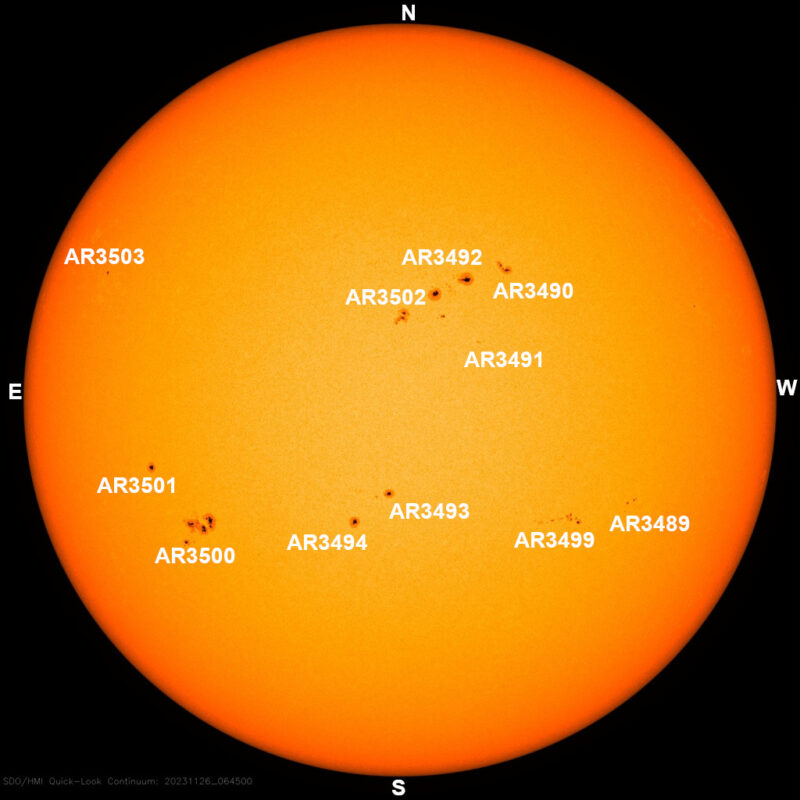
Sun activity for November 25, 2023: CME(s) hit Earth this morning
EarthSky sun activity author Dr. C. Alex Young also produces @thesuntoday.
A CME is here. It’s a great burp of material and magnetic fields from the sun. Scientists detected its impact earlier today, at 8:35 UTC. The result is a minor disturbance in Earth’s magnetic field – a G1 geomagnetic storm – which began at 8:59 UTC today and which should be causing auroral displays now. By tonight, the auroras might extend into latitudes like those in the northern U.S. Aurora alert! Multiple CMEs left the sun on November 22, and this impact is due to one or more of these events. Auroras will be possible tonight for latitudes as far south as North Dakota and Montana in the U.S. This increase in geomagnetic activity should continue through today, with possibly more storming through tomorrow.
Last 24 hours: While the auroral excitement continues at Earth, it seems the sun hit the snooze button. Sun activity due to flares has decreased to low levels within the past 24 hours (11 UTC yesterday to 11 UTC today). The observation period only saw four C flares despite a sun covered with a plethora of 11 active regions. A couple of them show delta magnetic complexity, which could bring M or even X flares. The largest flare of the past day was a C5.6, from active region AR3495. It occurred at 22:19 UTC on November 24. This same active region, AR3495, is the lead flare producer of the day with two C class flares. The sun is also covered with filaments on the solar disk, which have the potential for eruptions and, thus, more CMEs. The sun has 11 labeled active regions on the Earth-facing side.
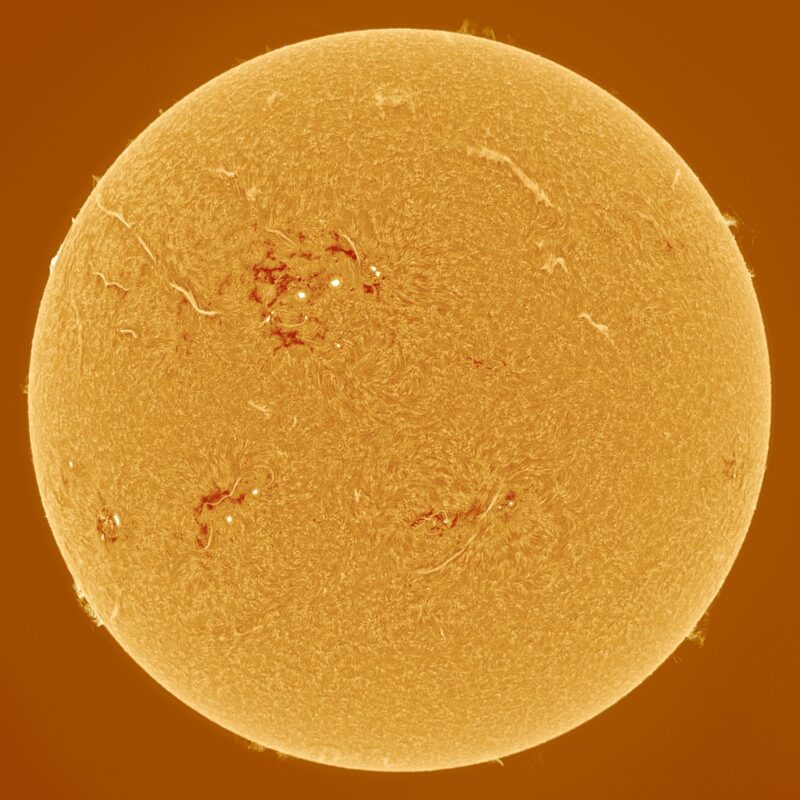
Sun activity for November 24, 2023, is on the rise across the board
Sun activity is increasing significantly. Over the past day we saw not only more flares than the previous day, but more M flares, too. These flares were joined by several more filament eruptions and coronal mass ejections. And while the size of individual sunspots on the Earth-facing disk is not remarkable, the number of sunspot regions is; we can currently see 13 of them, an increase of three from yesterday’s total. And sunspot region complexity is increasing, too. Three of the 13 active regions now have a delta complexity, which indicates a good possibility of producing intense flares. In fact, AR3500 has a beta-gamma-delta region – the most complex magnetic configuration – so perhaps we’ll see large M or even X flares from this sunspot group. Stay tuned!
Last 24 hours: A couple of M flares have kept sun activity at moderate. On top of those, we observed 18 C flares between 11 UTC yesterday and 11 UTC today. The two M1.1 flares occurred at 14:37 UTC on November 23 and 9:33 UTC on November 24, blasted by AR3490 in the northeast and AR3499 in the southwest, respectively. They caused R1 (minor) radio blackouts over South America off the east coast of Brazil and over the Mozambique Channel in South Africa. AR3492’s five C flares made it the most active region. AR3490 and AR3502 are the two regions with delta configurations, while AR3500 has a beta-gamma-delta configuration. The three new sunspot regions are AR3499, AR3500 and AR3501.
EarthSky sun activity author Dr. C. Alex Young also produces @thesuntoday.
Sun activity for November 23, 2023: M flare outshone by a volley of eruptions
EarthSky sun activity author Dr. C. Alex Young also produces @thesuntoday.
An M1.5 flare has brought activity up to moderate, but its limelight has been stolen by three fast filament eruptions in the northeast. First, a large filament – that is, a rope of solar material and magnetic fields – exploded from just over the northeast limb at 2:14 UTC this morning. Then another filament from over the northeast limb erupted at 5:29 UTC, followed by another at 6:59 UTC. These eruptions appear to be coming from an energetic region that has not quite yet rotated into view. While the M1.5 flare technically produced more light emission than the eruptions, the notable brightening of the filaments stole our attention away from the flare. The three eruptions produced coronal mass ejections (CMEs) that were visible in the SOHO spacecraft’s LASCO C2 instrument. These are all under analysis to determine if any are coming Earth’s way.
Last 24 hours: Sun activity is moderate after an isolated M flare. Between 11 UTC yesterday and 11 UTC today, the sun produced ten flares: one M and nine Cs. The largest, the M1.5 flare, came from sunspot group AR3494 in the southeast at 3:38 UTC on November 23. Shortly after this flare, an R1 (minor) radio blackout was registered affecting an area over off the northwest coast of Australia. The most active region of the period was AR3492 in the northeast with five C flares. There are currently nine numbered active regions on the Earth-viewed side of our star. Two of them, AR3490 and AR3492, are showing a beta-gamma configuration. The rest remain stable with alpha or beta configurations.
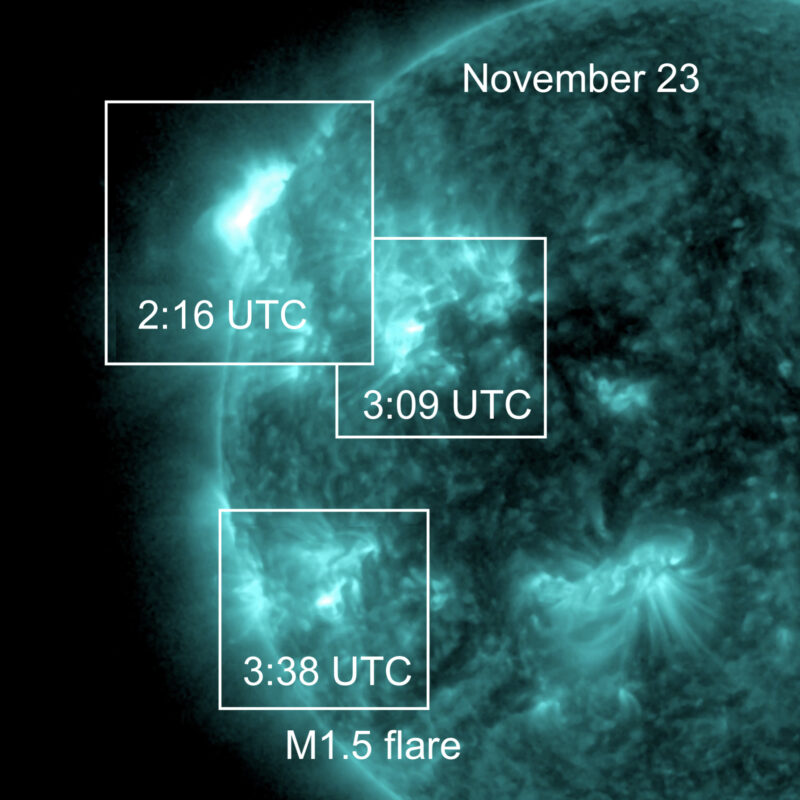

Sun activity for November 22, 2023: Earth is blowin’ in the solar wind
EarthSky sun activity author Dr. C. Alex Young also produces @thesuntoday.
Auroras on the way tonight! Fast solar wind is now buffeting Earth, and our geomagnetic field has been disturbed enough to cause a G1 (minor) geomagnetic storm. This threshold was reached at 5:50 UTC this morning, and the storm is continuing at the time of this writing. Did you catch the auroras this morning? If not, don’t worry; conditions for auroras should persist through today and tonight. That includes the chance for those in northern US states to see auroras on the horizon – that’s what’s indicated by the thin red line on the chart above. Get your cameras ready for possible auroras tonight, and be sure to share your beautiful photos with us.
Last 24 hours: Although the sun is peppered with sunspots, sun activity remains low today with only C flares. From 11 UTC yesterday to 11 UTC today we saw 14 C flares, the largest being a C8.9 from sunspot group AR3492 at 6:28 UTC on November 22. This group remains the most active region, producing nine flares. AR3489 lost its delta region and is now only a beta region. AR3494 kept its beta-gamma configuration. Although flaring is low, filaments and prominences continue to dazzle us. A prominence hanging out near the southern limb gave us a great eruption, firing out a coronal mass ejection (CME) that is probably not Earth-bound. The sun currently has nine labeled active regions. The newest of these is AR3498 in the southwest.
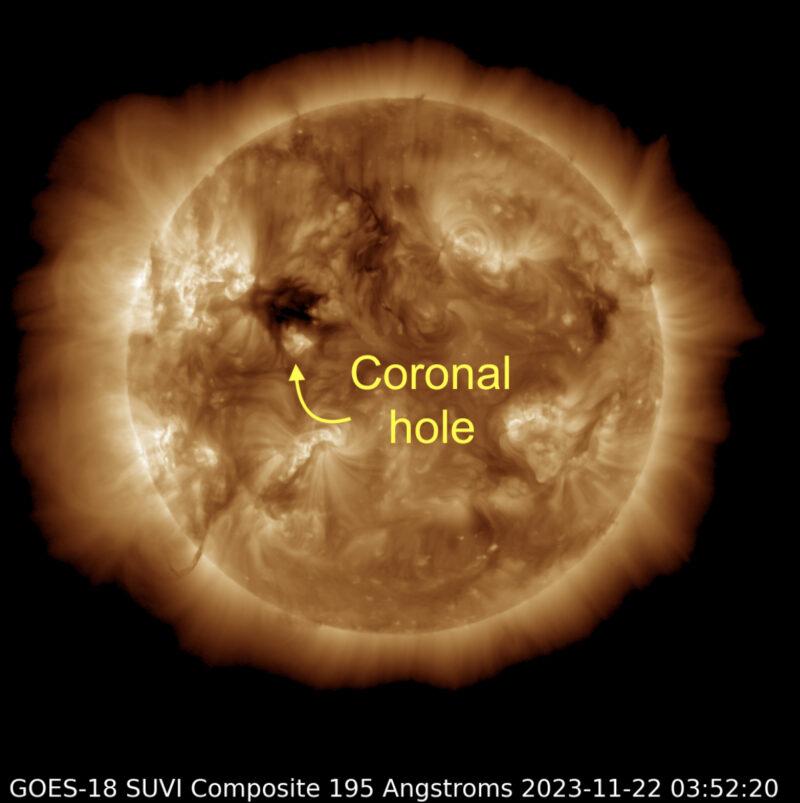
Sun activity for November 21, 2023: Sun-sational action ahead?!
EarthSky sun activity author Dr. C. Alex Young also produces @thesuntoday.
As we’ve been reporting, the sun has been nearly spot-free these past few days. There were only three sunspot groups early yesterday. Then suddenly – bang – there were nine. It was a lot of fun to watch! The most notable part of this sudden explosion of sunspots came from AR3490, which the sun’s rotation has now carried further into view on the Earth-facing side of our star. As we watched, this region suddenly split into multiple sunspot groups. What does this new archipelago of sunspots mean? It might mean some big flares. There might be M and possibly even X flares in the coming days. The new regions aren’t particularly large. But some now have a promising level of magnetic complexity, often a sign of potentially large flares on the horizon. For example, sunspot region AR3489 has a beta-delta configuration. The delta classification indicates a mixture of magnetic polarities within a single sunspot. And that’s a recipe for some sun-sational action. Stay tuned!
Last 24 hours: Despite the potential activity we just mentioned, sun activity over the past day has been low. We saw only C flares, 16 in all from 11 UTC yesterday to 11 UTC today. The largest was a C8.0 flare from sunspot region AR3492 in the northeast quadrant at 12:31 UTC on November 20, 2023. This group has an interesting beta-gamma configuration. And it was the lead flare producer of the past day with 12 of the 16 flares. The sun has nine labeled active regions on the Earth-facing solar disk. There are six newcomers today: AR3492, AR3495, AR3496 and AR3497 on the northeast quadrant and AR3493 and AR3494 on the southeast limb (edge).
EarthSky sun activity author Dr. C. Alex Young also produces @thesuntoday.
Solar max is coming
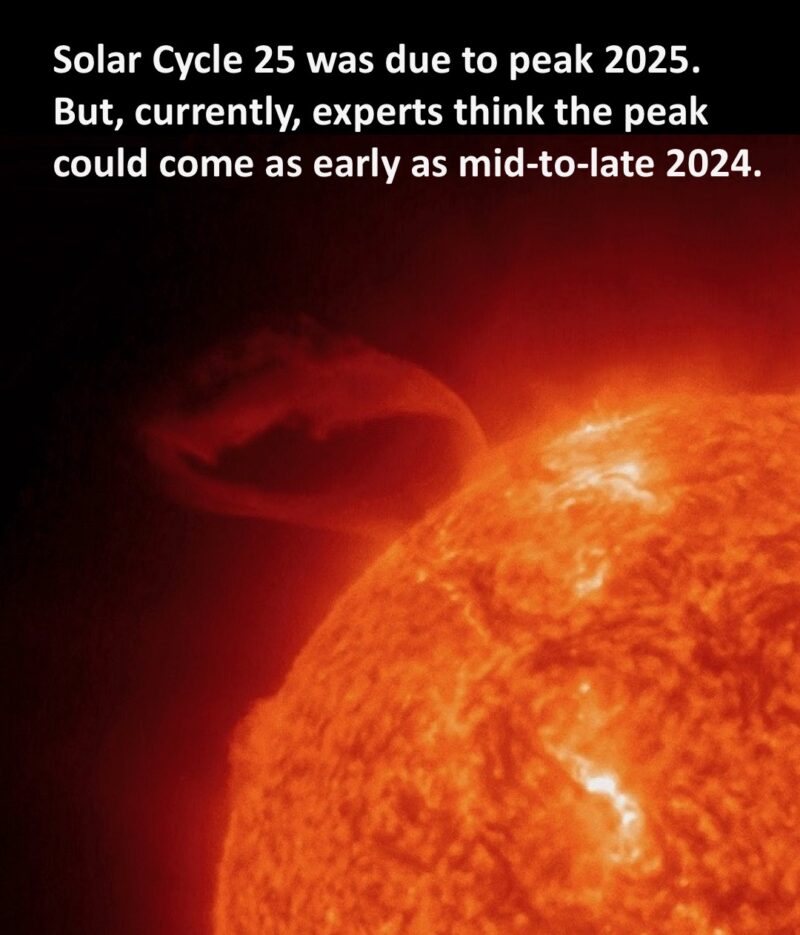
A coronal mass ejection (CME) was expected to strike Earth late yesterday. But it hasn’t made it to Earth yet. Meanwhile, forecasters still believe it will impact our planet and bring an auroral display to high latitudes. As we wait for it, the sun continues to entertain us with a festival of filaments. They take the form of the long plasma ropes across the sun that can be more than 400,000 miles (700,000 km) long, or even longer. We also see some sitting, or dancing, on the sun’s limb (edge); in that case, we call them prominences. And two can be seen erupting from behind the sun’s limb, in the northeast quadrant, and then the northwest. It’s quite a show. And it’s a bit mind-blowing to know that each one of these filaments is made up of billions of tons of solar material. That sounds like a lot, but it’s only a tiny fraction of the mass of the sun. Our star contains a billion billion billion tons of material!
Last 24 hours: Sun activity is now moderate, with the production of an M1.2 flare from sunspot region AR3490. It happened at 8:54 UT today (November 20). The M flare produced an R1 radio blackout over Africa and the Indian Ocean. The sun produced 16 flares over the past day (11 UTC yesterday to 11 UTC today). Five of the flares came from AR3489, and five from AR3490. The sun has three labeled active regions on the Earth-facing solar disk.
Sun activity for November 19, 2023: Fun filaments and CMEs galore!
Today’s top news: It’s a day of flying filaments. Looking along the limb (edge) of the Earth-facing sun, we see numerous eruptions, small and large, front-sided and back-sided. It makes for quite a show. With the SOHO C2 and C3 coronagraphs, we can follow the eruptions further into space. These red, fire-like structures change into coronal mass ejections (CMEs), which are great wispy clouds of solar particles and magnetic fields. All of the events from the past day look to be heading away from Earth. But further analysis will provide more certainty about that. And, meanwhile, there are several large filaments on the solar disk. Two of these giant plasma ropes are at least 700,000 km (430,000 mi) long. If one of them should erupt, an Earth-directed CME is highly likely.
Last 24 hours: Sun activity is moderate with the production of two M flares. The newly numbered active region we spoke about yesterday has now rotated full into view, receving the sunspot number AR3490. And, sure enough – as we thought it might – it produced these M flares. The first was an M1.1, occurring at 16:34 UTC on November 18. And the second was an M1.0, occurring at 22:26 UTC on November 18. The region produced 10 of the 19 flares of the past day (11 UTC yesterday to 11 UTC today). The M flares each produced an R1 radio blackout over South America and the Pacific, respectively. The sun now has three labeled active regions on the Earth-facing solar disk, in contrast to just two yesterday.
Sun activity for November 18, 2023: A new active region appears
A new active region has begun to rotate into view on the Earth-facing side of the sun. It’s already brought sun activity up to moderate levels, thanks to an M1.2 flare. This as-yet-unnumbered region promises to kick things up a notch. Helioseismology also shows another region on the far side, not too far behind. Currently, the sun has two labeled active regions. That should soon change. But wait, there’s more! Filaments – lots of filaments – cover the sun, and two have lifted off. The first is from the northeast limb (edge) near the north pole. This produced a nice prominence and sent a coronal mass ejection (CME) headed northward, probably away from Earth. The second eruption is a bit more subtle but still visible. This was a filament on the disk, just to the east of region AR3489. This may have a somewhat Earthward component, but that is not clear at the moment. The new region along with AR3489 and AR3486 have all been prolific jet producers. We also have a CME on the way to look forward to on November 19. It brings the possibility of auroras, so stay tuned.
Last 24 hours: Sun activity is moderate with the production of an isolated M1.2 flare at 5:42 UTC on November 18, 2023. This is from the new, as-yet-unnumbered region on the northeast limb. This M flare caused an R1 (minor) radio blackout, which affected an area over the South Indian Ocean off the west coast of Australia. This makes a total of seven flares (including six Cs) between 11 UTC yesterday and 11 UTC today. The new region on the northeast produced five of today’s seven flares. The sun has two labeled active regions on its Earth facing side. One of these is a newcomer on the southeast limb (edge), AR3489.
View this post on Instagram
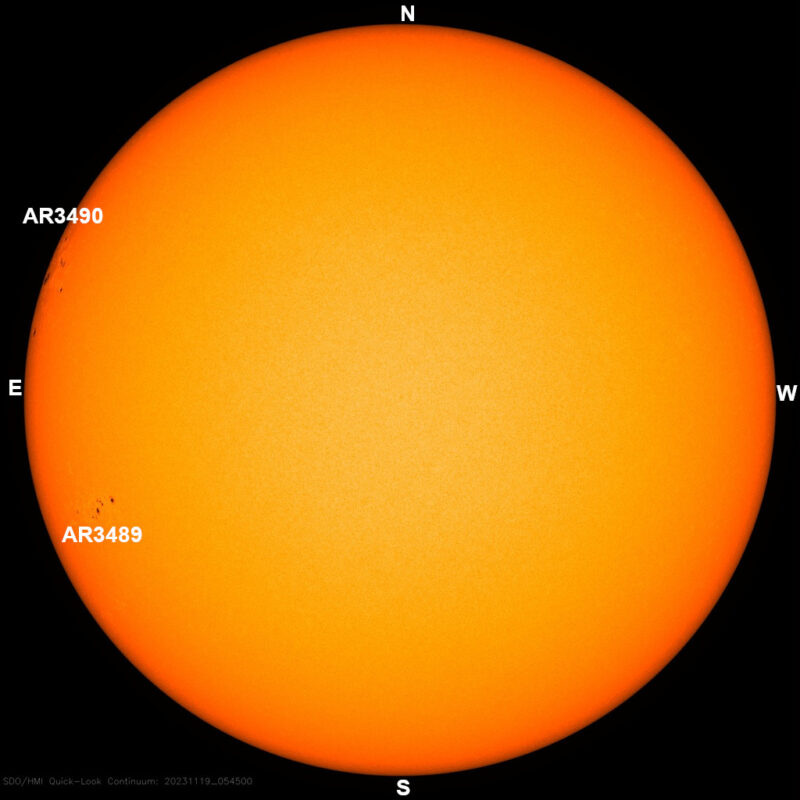
Sun activity for November 17, 2023: Here comes a blast from the sun
Yesterday, a filament – a rope of solar material and magnetic fields – erupted, firing plasma into space as a coronal mass ejection (CME). And now, analysis from NOAA space weather forecasters has found that this partial halo CME was in the sun-Earth line – in other words, this bubble of superheated plasma is on a course for Earth. The estimated time of arrival is late November 19, and space weather forecasters are predicting a possible G1 (minor) geomagnetic storm as a result of its impact. That could mean auroras! Get ready, aurora watchers.
Last 24 hours: Sun activity is low, with just four C flares and one B observed between 11 UTC yesterday and 11 UTC today. The largest flare was a C4.9 at 20:22 UTC on November 16. It came from an active region in the southeast that has not yet been labeled. This unnumbered sunspot was the only flare producer of the period. The sun has two labeled active regions on its Earth-facing side – one of the lowest sunspot numbers of the year. However, the lack of sunspots and flares hasn’t stopped the filament fun. Enjoy today’s imagery of a filament channel activation (an active flow of plasma along a filament), which followed an S-shaped path between two active regions. And at the north pole, a stable filament danced as a prominence off the solar limb (edge).
?? ? Sun activity for Nov 17, 2023: Here comes the sun or at least a piece of it. Yesterday’s CME should bring geomagnetic storms Nov 19. Filaments activate as a prominence dances over the North Pole.
? ? More at EarthSky: https://t.co/xD29wLfm4e #sunfun pic.twitter.com/7DVGH1hRKL
— Dr. C. Alex Young (@TheSunToday) November 17, 2023

Sun activity for November 16, 2023: Far side action could head our way
A huge filament eruption formed a beautiful prominence this morning – see the rope of solar material and magnetic fields soar out over the southwest limb (edge) in the animation above. And at 8 UTC yesterday, the SOHO spacecraft’s LASCO C3 instrument observed a huge partial halo coronal mass ejection (CME) erupting from the north. In both cases, the lack of an associated event on the Earth-facing side of the sun means that they must have come from its far side. This is supported by the observations of helioseismologists, who have measured sound waves emitted from inside the sun to detect large sunspots on sun’s reverse. As the sun is constantly rotating, these regions should be coming into view from Earth over the next four or five days. Stay tuned to see if they survive the trip and bring the party to our side!
Last 24 hours: Although you might not think it looking around the solar horizon, sun activity is back to low. We observed only 11 C flares between 11 UTC yesterday and 11 UTC today. The largest flare was a C7.7, fired at 12:12 UTC on November 15 by sunspot group AR3485, one of yesterday’s top flare producers. The top producer today is AR3484, which fired four flares. The sun currently has three numbered active regions on its Earth-facing side.
Sun activity for November 15, 2023: Big flare day
Whoa! A big increase in flaring! The sun produced 29 flares over the past 24 hours, in contrast to to 19 the day before. It’s a sizable jump, especially considering that last week’s sun averaged just 5 flares a day. Elsewhere on the sun, one of the prominences (ropes of solar material and magnetic fields) that we saw yesterday on the sun’s southwest limb (edge) lifted off into space as a billion-ton blob of plasma. This coronal mass ejection (CME) is heading away from Earth. But another CME is on its way toward us. That earlier CME left the sun on November 10 and is expected to give Earth a glancing blow later today. This could cause auroras, so keep an eye out.
Last 24 hours: Sun activity is now considered moderate (in contrast to yesterday’s low), not because of the number of flares, but because one of them was an M1.1 flare. The M came from yesterday’s plasma jet producer, AR3485. It blasted off the sun at 23:05 UTC on November 14. And it caused an R1 (minor) radio blackout over French Polynesia. So the sun produced 29 flares between 11 UTC yesterday and 11 UTC today, up from 19 the previous day. All were C flares, apart from the M1.1. The lead flare producer mantle is today shared by three active regions: AR3485, AR3483 and AR3477. The sun currently has five numbered active regions on its Earth-facing side, including new sunspot group AR3488, which emerged on the northeast limb (edge).
Sun activity for November 14, 2023. See a solar jet blast sun-stuff into space
Today’s top news: Over the past day, we saw beautiful active filaments all over the Earth-facing sun. And early this morning, we saw the solar jet in the image above, extending from the sun’s outer atmosphere. This jet isn’t made of ordinary matter. It’s a collimated, beam-like ejection of what’s called plasma, a 4th state of matter, consisting of elementary particles and magnetic fields from our blazingly hot star. It’s this solar plasma that interacts with the larger environment of our solar system to give us space weather, and ultimately auroras. Sunspot group AR3485 produced this solar jet. This sunspot region is now getting closer to the sun’s southwestern limb (edge). Soon, it’ll rotate out of sight. So enjoy its activity while you can. By the way, thanks to everyone who shared aurora photos at EarthSky Community Photos this week. Auroral activity has been grand for some days now. Earth’s magnetic field is quiet now, but don’t put your cameras away just yet, as more auroras might be visible tomorrow. Read more below.
Last 24 hours: The sun produced 19 flares between 11 UTC yesterday and 11 UTC today, an increase from 12 flares in the previous 24-hour period. All 19 were C class flares. So activity is currently considered low. The largest event was a C2.9 flare from sunspot region AR3477 in the southwest. It was produced at 20:50 UTC on November 13. The lead flare producer was AR3485 with eight Cs, closely followed by active region AR3484 with seven. The sun currently has five numbered active regions on its Earth-facing side. A new sunspot group, AR3487, emerged in the southwest.
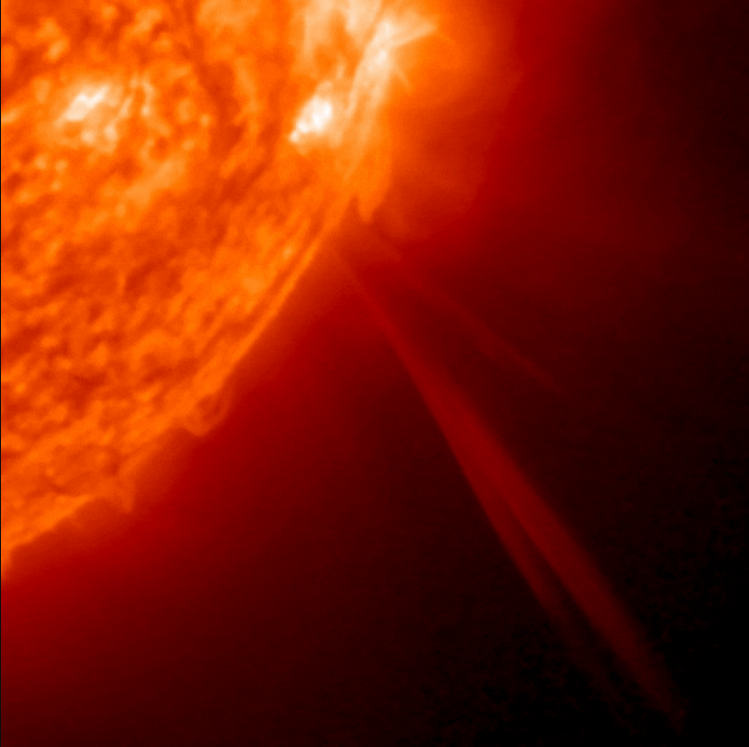
Sun activity for November 13, 2023. Auroras last night, and a photobomb
Earth’s moon just photobombed our cameras aimed at the sun. Our natural satellite moved across the sun from the perspective of the NOAA GOES spacecraft, which captured the photobomb via its SUVI extreme ultraviolet telescope. See the image below. Meanwhile, the great burp of solar material that gave Earth a glancing blow yesterday – called a coronal mass ejection (CME) – was still enough to set off a fine aurora night last night across Earth’s higher latitudes. We might see some more today from lingering CME effects and from high speed solar wind that originated from a coronal hole. Either way, aurora-watchers, stay tuned to the sky!
Last 24 hours: In terms of flaring, sun activity is low. The sun produced 12 C flares between 11 UTC yesterday and 11 UTC today. The largest was a C2.2 from active region AR3484 at 01:40 UTC on November 13. AR3484 remained the most active region with 9 flares including the C2.2 flare. The sun currently has four numbered active regions on its Earth-facing side.
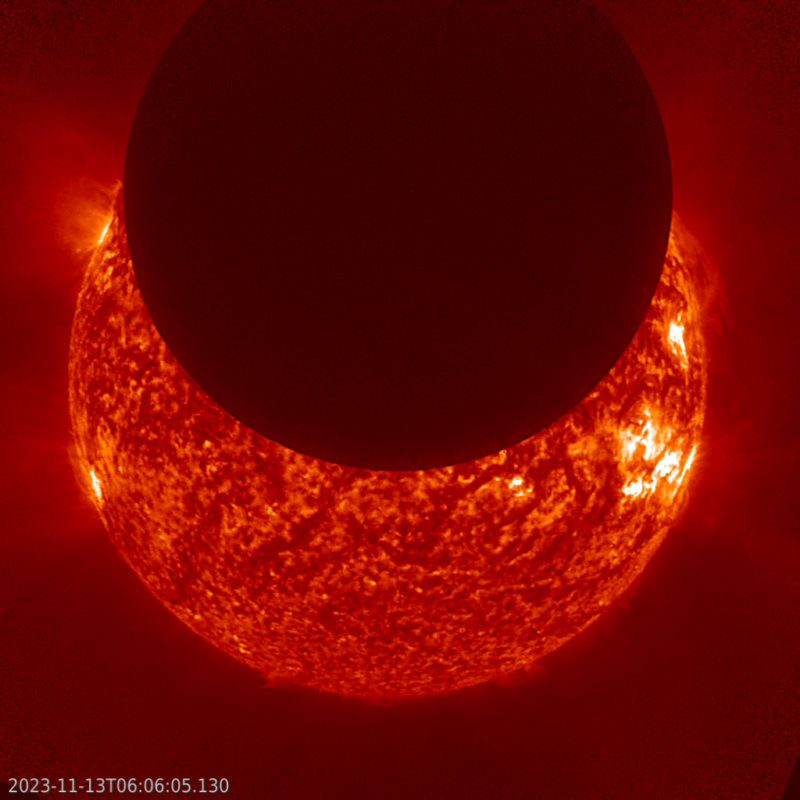


Sun activity for November 12, 2023, is moderate. Aurora alert!
Today’s top news: Sun activity has kicked up to moderate, thanks to an M1.2 flare from AR3477. And activity at Earth has picked up, due to the expected arrival of a coronal mass ejection (CME) earlier today (around 6 UTC today on November 12). A glancing blow by this CME has energized Earth’s magnetic field to active levels with the possibility of G1 through G3 (minor to strong) storming today. And that means auroras! Clear skies and good luck to all aurora-watchers. Please share your photos in our community page. Stay tuned for more updates.
Last 24 hours: Sun activity is moderate. The sun produced 21 flares between 11 UTC yesterday and 11 UTC today. The largest was an M1.2 from active region AR3477 at 17:01 UTC on November 11. AR3477 remained the most active region with 7 flares including the M flare. The sun currently has six numbered active regions on its Earth-facing side.

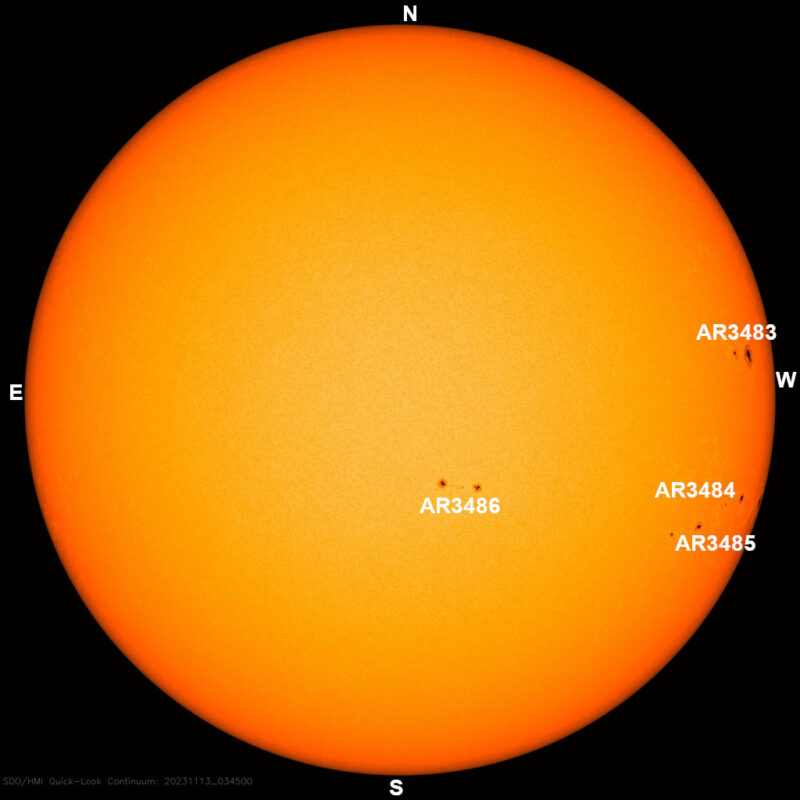
Sun activity November 11, 2023: Flares are increasing. CME arrives tonight
Flare production increased over the last 24 hours, with up to 20 C flares in the past day. All the action is on the western portion of the sun, in both the north and south quadrants. In particular, the northwestern region produced a fiery filament explosion in the vicinity of sunspot AR3481. It occurred at 7 UTC on November 11, 2023. The blast sent ejecta into space. Shortly before, active region AR3483 – also in the northwest – exploded the largest flare of the day, a C7.2 flare at 3:59 UTC. Turning our eyes back to Earth, we expect a CME arrival and possible auroras late today into early Sunday. It comes after the full halo event yesterday that hurled a giant burp of solar material into space. G1-G2 (minor-moderate) geomagnetic storming is expected. So there’s more excitement coming. Aurora watchers, we’re wishing clear skies for you! Share your beautiful photos with us.
Last 24 hours: Sun activity is still considered low. But production has increased significantly during the past day. The sun produced 20 C flares between 11 UTC yesterday and 11 UTC today; a big increase compared to the approximately five flares a day it has been blasting out in recent days. The largest was a C7.2 flare blasted by active region AR3483 at 3:59 UTC on November 11. This increase in flaring activity is thanks to AR3477 in the southwest, which produced 11 C flares, followed by AR3483, which blasted seven Cs, including the largest of the day. The sun currently has five numbered active regions on its Earth-facing side. They’re all located in the west hemisphere, north and south. There is a newcomer today, now named AR3485, in the southwest solar quadrant.
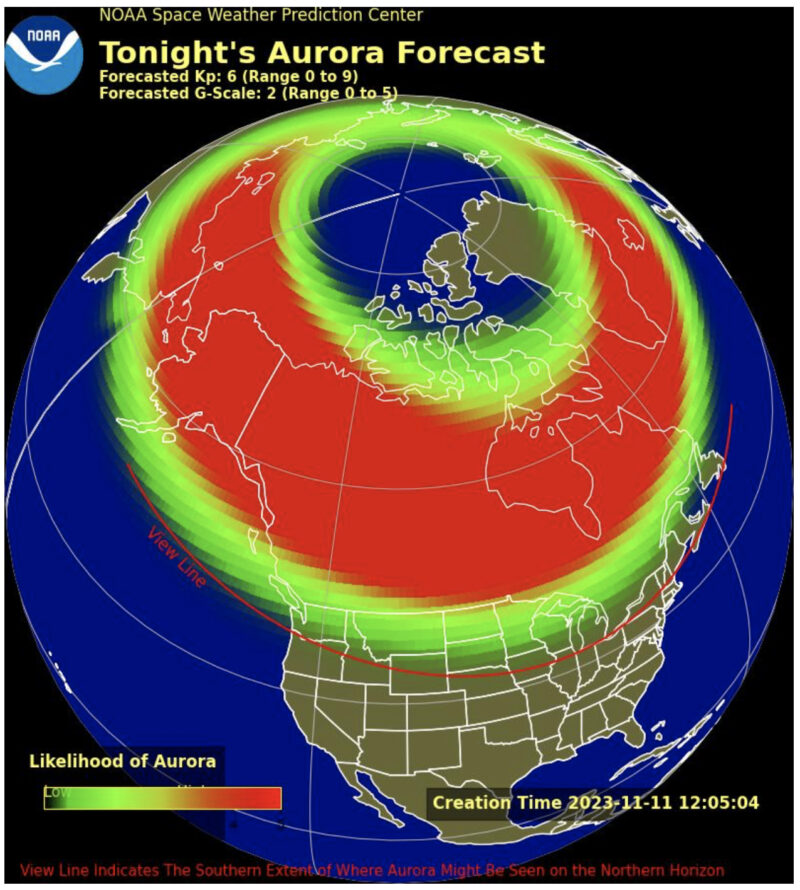
Sun activity November 10, 2023: CME coming straight to us!
After Sunday night’s fabulous auroral display – and with solar max on the horizon (due mid-decade), we’re all wondering, when will we next see auroras? And the answer might be … soon. A coronal mass ejection (CME) is on its way to Earth! Yesterday at 11:15 UTC we saw the explosion of a solar filament (a long rope of magnetic fields and solar material). The eruption blasted some of the material into space as a coronal mass ejection (CME), a great burp of solar material to space. Since the CME was fired directly towards Earth, the SOHO spacecraft saw a ring of solar material that seemed to expand out from the sun – a phenomenon known as a full halo event. Check out the imagery above! Specialists estimate the CME will reach Earth by tomorrow afternoon, likely bringing G1 (minor) or G2 (moderate) geomagnetic storms. Get ready for more auroras!
Last 24 hours: Despite the CME excitement, sun activity is still low. Between 11 UTC yesterday and 11 UTC today, the sun produced five C flares and two B flares – an increase of one B flare from yesterday’s levels. The CME-producing filament eruption occurred in the vicinity of sunspot AR3480, and has been associated with a C2.6 flare from this active region. Fired at 11:18 UTC on November 9, this was the largest flare of the past day. With two total flares, this region shares today’s lead flare producer title with AR3479. The sun currently has seven numbered active regions on its Earth-facing side. AR3483 has lost its beta-gamma magnetic complexity, bringing it in line with the rest of the visible sunspots, which all have simpler beta configurations.
Sun activity November 9, 2023: Dancing prominences, plus jets and filaments
Although sun activity is classed as low, we’ve been seeing faint flares and jets all around the solar disk over the past day, as well as a long-lasting prominence on the north pole. It’s been dancing mesmerizingly all day long right on the horizon – we’ve found it hard to stop watching! Elsewhere, sunspot region AR3483 has been growing since its arrival yesterday, and has kept up its explosive activity. It has now developed a beta-gamma magnetic complexity, meaning that it has good potential to produce intense solar flares. And it’s the only sunspot that has this configuration currently; the rest of the labeled regions have much simpler beta or even alpha configurations.
Last 24 hours: Sun activity remains low, and flaring production has dropped since yesterday. Between 11 UTC yesterday and 11 UTC today, the sun produced five C flares and one B flare. The largest was a C4.2 by active region AR3483, fired at 20:13 UTC on November 8. This region was actually the only flare producer of the period, blasting all six flares. AR3477 remains the largest sunspot, but kept relatively quiet. The sun today has six numbered active regions on its Earth-viewed side. One is a newcomer: AR3484 on the southwest quadrant.
Sun activity November 8, 2023: After the storm, a calm…but wait!
After the geomagnetic storms and beautiful auroral displays of the past few days, the sun seems to be having a moment of calm. But wait! A violent eruption occurred just at the time of this writing! The event produced a beautiful prominence on the northwest limb (edge). The event was in the vicinity of sunspot group AR3479, which has been particularly explosive today. The eruption fired solar material into space as a coronal mass ejection (CME), but AR3479’s position on the sun means that the CME doesn’t seem to heading toward Earth. Nevertheless, we’ll wait and see what the specialists conclude from their modeling.
Last 24 hours: Sun activity remains low today, but flaring production has increased. Between 11 UTC yesterday and 11 UTC today, the sun produced 16 C flares. Sunspot group AR3479, blasted at around 7 UTC on November 8 an explosion that produced a gorgeous prominence in the northwest. The largest flare of the past day was a C6.9 flare by AR3483 who was also the lead flare producer of the period, firing ten of the day’s 16 C flares. The blast occurred at at 8:48 UTC on November 8. Sunspot AR3480 has lost its gamma configuration, lowering its potential for big flares, while AR3477 continues to be the largest sunspot. Currently the sun bears five labeled active regions, all of which are stable or in decay. There is a newcomer located at the very center of the solar disc, labeled AR3483. Also, the large coronal hole we’ve been monitoring is now moving out of its geoeffective position, meaning we will stop receiving the fast solar wind that helped cause the recent auroras.
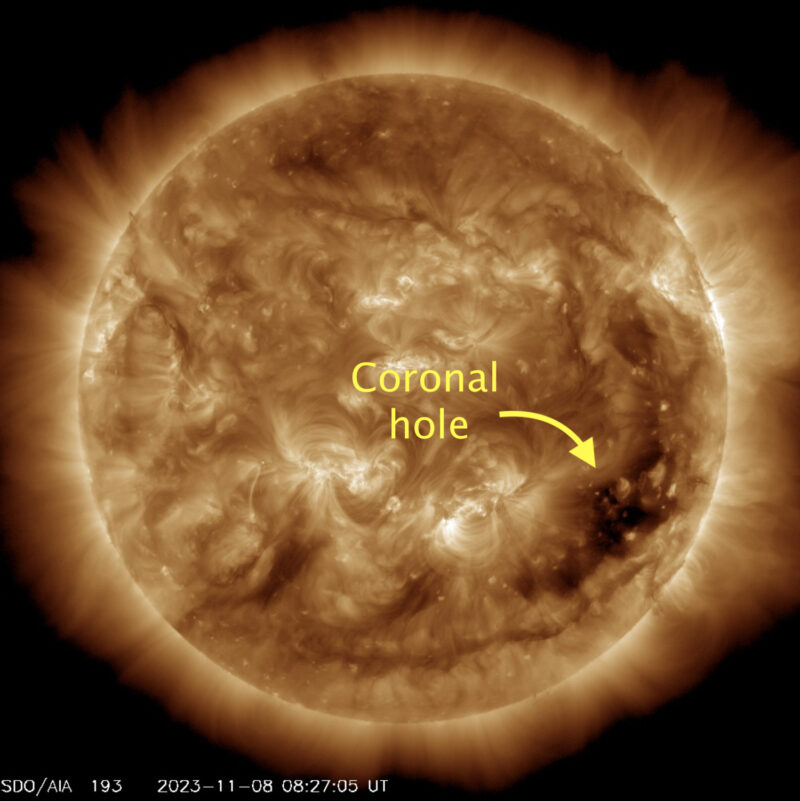
Sun activity November 7, 2023: What a week for auroras. More coming?
After the beautiful auroral displays of Sunday night, last night was calmer. But Earth’s magnetic field remains stormy. Another threshold for yet more G1 (minor) geomagnetic storming was observed at 2:30 UTC this morning. This big week for auroras has been the result of several coronal mass ejections (CMEs) – great blobs of material from the sun – striking Earth on November 5. The CMEs combined with incoming fast solar wind from a coronal hole to add up to auroras! Thank you for your beautiful photos. Keep ’em coming! Submit to EarthSky Community Photos here.
Last 24 hours: Sun activity is low today, but a gorgeous prominence formed an arch on the northeast limb (edge) at around 14 UTC yesterday. Plasma can be seen forming an almost closed loop before dissipating as the ejecta returned back to the sun. Eight C flares were produced between 11 UTC yesterday and 11 UTC today, the largest being a C3.6 flare from sunspot region AR3474 at 14:02 UTC on November 6. The leading flare producer was AR3472, which produced three of the eight flares. The sun currently has five numbered active regions on its Earth-facing side.

Sun activity November 6, 2023: Aurora, Aurora, Aurora!
What a night Sunday night was for auroras! Thanks to 24+ hours of geomagnetic storms, those at high and even mid-latitudes were witness to some amazing auroral displays. We are sharing a bunch of Twitter (X) posts below. But this is just a small sampling. The storming came about thanks to multiple coronal mass ejection (CME) impacts over the past two days. There were at least two impacts, and possibly three or more. None of these were particularly spectacular individually (though one is super interesting, because it was due to a filament eruption). But, combined, they’ve really gotten Earth’s magnetic field worked up! So much so that we reached G3 (strong) storming levels late yesterday (November 5). And the storming isn’t over yet. But it should start to settled down a little over today as the CMEs’ influence wanes. But CMEs aren’t the only influence on Earth’s magnetic field. A coronal hole on the sun is also sending its fast solar wind our way. That’s why we expect geomagnetic storming levels – and subsequent auroral displays – to stay active over the next couple of days.
Last 24 hours: Sun activity has picked up to moderate levels thanks to two small brief (impulsive) M flares from AR3480. Overall, the sun produced two M flares and 15 C flares from 11 UTC yesterday to 11 UTC today. The largest was an M1.8 flare from AR3480 at 11:34 UTC on November 5, 2023. The other M flare was an M1.7 from AR3480 at 14:24 UTC on November 5. Both events produced an R1 radio blackout over the sun-facing area of Earth. AR3480 produced eight of the 15 flares including the two M flares. The sun has seven numbered active regions on its Earth-facing side.
Sun activity for November 5, 2023: The CME is here
Today’s top news: Yesterday we said the coronal mass ejection (CME) from the filament eruption on November 3 might reach Earth today. And so it has. A CME is an enormous bubble of superheated gas – called plasma – ejected from the sun. CMEs can leave the sun every day when the sun is most active (and we’re near the peak of Solar Cycle 25 now). But the CMEs aren’t always aimed Earth’s way. This one was, though. Our instruments recorded its arrival in the form of a sudden change in the geomagnetic field – what solar physicists call a sudden jerk or impulse – at 9:05 UTC November 5. We can see this in the solar wind data as a sudden increase in magnetic field, solar wind speed and solar wind density (see the chart below). It’s basically the front part of the CME slamming into the planet. Earth’s magnetic field has reached G1 (minor) storming levels. G2 (moderate) and possibly G3 (strong) levels are expected to follow. This is great for aurora watchers! If you’re at a high latitude – maybe northwestern Canada or Alaska – and it’s still before sunrise on November 5 as you read this, you might start your day with a great show in the sky!
Last 24 hours: Sun activity is low. During the past day (between 11 UTC yesterday and 11 UTC today), the sun produced three C flares. The largest was a C1.8 flare from sunspot AR3472 at 13:46 UTC on November 4, 2023. The sun has seven numbered active regions on its Earth-facing side.

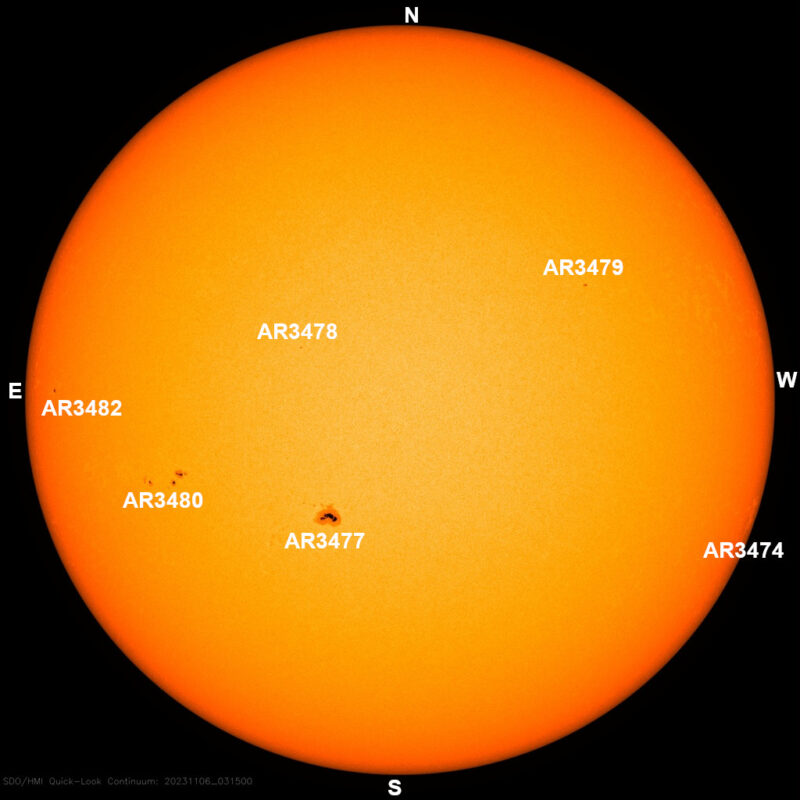
Sun activity for November 4, 2023, The 20th anniversary of the largest solar flare
Today is the 20th anniversary of the largest solar flare of the space age. Between October 19 and November 5, 2003 – during the waning part of sunspot Cycle 23 – a set of three surprisingly large sunspot regions emerged on the Earth-facing disk. They came into view after a period of relative calm on the sun. These massive, magnetically complex regions were the source of some of the largest space weather events ever seen. Sun-watchers called them the Halloween Storms. They produced mighty X flares, including X10 and X17 flares (10 and 17 times an X1 flare). One flare – on October 28 – produced an extremely fast coronal mass ejection (CME) originating from the center of the sun’s disk. It produced a huge geomagnetic storm – on par with the famous Carrington Event – which did have impacts across Earth’s globe, for example, disruption to radio communications, air traffic control and power grids. But the big event of the Halloween Storms of 2003 was yet to come. It was the largest flare of the period – even larger than the Carrington Event flare must have been – coming at around 19 UTC on November 4. The solar flare was off the charts! Scientists could only estimate its strength: from X28 to X45, with an average estimate of about X40. It was the largest solar flare ever observed directly. Fortunately, it came from one of the large sunspot regions just over the sun’s western (receding) limb or edge. So we dodged a bullet!
Last 24 hours: Sun activity is back to low. During the past day (between 11 UTC yesterday and 11 UTC today), the sun only produced four C flares. The largest was a C3.5 flare exploded by sunspot AR3480 in the southeast at 22:38 UTC on November 3, 2023. Currently the sun is showing seven numbered active regions on its Earth-viewed side. The newcomer of the day is AR3480 on the southeast limb (edge). By the way, yesterday’s huge filament explosion produced a partial halo event. Specialists are conducting an analysis of the coronal mass ejection (CME) to determine if there is an Earth-directed component. Stay tuned, aurora-watchers.
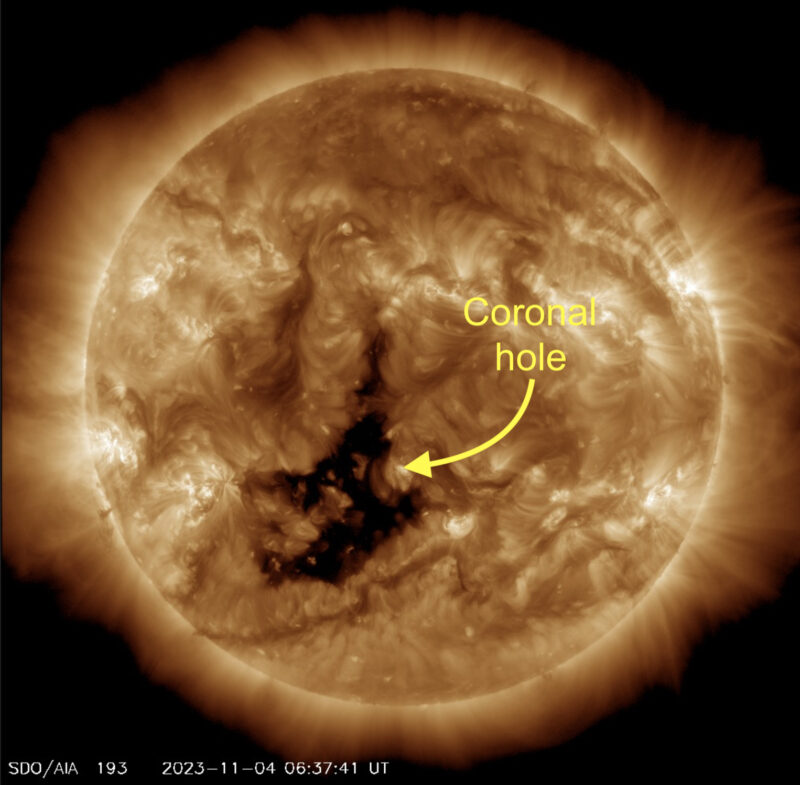
Sun activity for November 3, 2023, huge filament eruption and more M flares
A huge filament eruption occurred in the northwest at around 4:20 UTC on November 3. This rope of solar material and magnetic fields erupted in connection with a C1.4 flare from AR3473. While some of the plasma returned back to the sun, some was launched into space. As much of the filament is located in a geoeffective position, the solar material that was fired into space may be heading our way as a coronal mass ejection (CME). We’ll let you know when the specialists have completed modeling and analysis. With another filament explosion occurring farther north and two M flares being blasted elsewhere on the solar disk, it’s safe to say that solar action is back!
Last 24 hours: Sun activity remains moderate after the production of two M flares. The sun produced 12 flares between 11 UTC yesterday and 11 UTC today: two Ms and 10 C flares. The largest event, an M1.7 flare, came from active region AR3474 at 12:22 UTC, November 2. The second, an M1.1, was produced later that day at 19:21 UTC by the incoming active region on southeast limb (edge), which was also producing C flares, jets, and prominences all day. Each M flare produced an R1 (minor) radio blackout. The first affected an area over the South Atlantic Ocean, while the second occurred over Pitcairn Islands off the west coast of South America. The lead flare producer of the day was the as-yet-unnumbered region with six flares: one M and five Cs. Currently the sun has seven numbered active regions on its Earth-viewed side, including newcomer AR3479.
Sun activity for November 2, 2023, incoming region keeps flaring
An M1.4 flare from an incoming region on the southeast limb (edge) has kept sun activity at moderate. This region produced some of the action we’ve been observing over the past few days from beyond the east solar horizon. Another of the new eastern sunspot regions, AR3477, was less productive today, but AR3474 showed growth. It is now the largest region and the only one showing a beta-gamma configuration, meaning it holds the potential for more Cs and M flares. The rest of the active regions show lower-potential alpha or beta magnetic configurations.
Last 24 hours: Sun activity is moderate after an isolated M1.4 flare. The sun produced a total of ten flares between 11 UTC yesterday and 11 UTC today: nine Cs plus the M flare. The largest event, the M1.4 flare, was produced by an incoming region in the southeast at 12:26 UTC on November 1. This as-yet-unnumbered sunspot group was the leading flare producer of the period, with six out of the day’s ten flares. The runner-up was sunspot AR3472 with three C flares. The M flare caused an R1 (minor) radio blackout that affected an area over the South Atlantic Ocean. The sun currently has six labeled active regions on its Earth-facing side, including a newcomer on the northeast limb (edge) labeled AR3478. There is also a new coronal hole on the southeast solar quadrant. It’s big enough to nearly cross the equator, and could be the next important source of fast solar wind heading our way and disturbing our geomagnetic field.
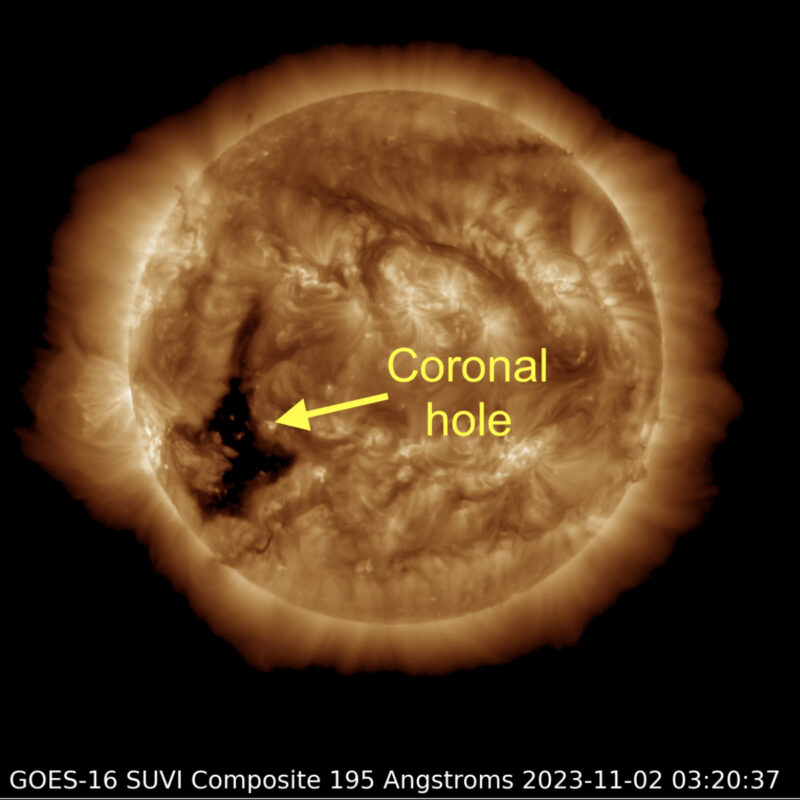
Sun activity for November 1, 2023: M flare and huge prominence eruption!
Sun activity is finally picking up! We observed an M flare and associated eruption from new region AR3477 on the eastern limb (edge). And it’s likely that the explosion was actually larger than an M1.2, because, since the event occurred over the horizon, the sun itself will have blocked much of the flare’s light. While AR3477 was doing its magic, a huge filament in the southeast erupted in a southward direction. The event is under analysis by space weather forecasters to determine if the associated coronal mass ejection (CME) might reach Earth. Initial observations indicated that it should miss us, but we will have to wait for further results. Stay tuned!
Last 24 hours: Sun activity is moderate, with an M flare and twelve C flares during the past day. For the first time in weeks, overall activity is on the rise thanks largely to new region AR3477. AR3477 produced most of the day’s events, firing off eight C flares and the one M flare. The largest event was the M1.2 flare, produced at 6:07 UTC on November 1. Shortly after the blast, an R1 (minor) radio blackout was observed affecting an area over the South Indian Ocean. The sun currently has five labeled active regions on the Earth-facing side.











